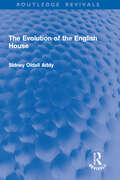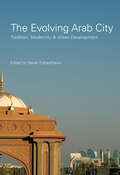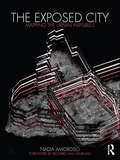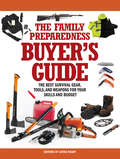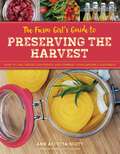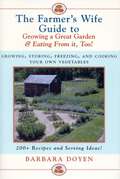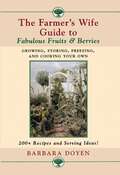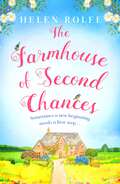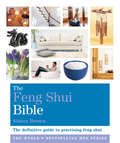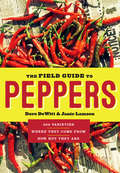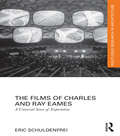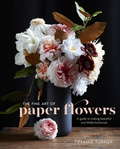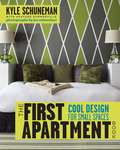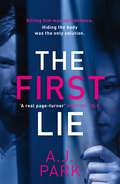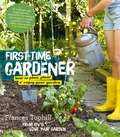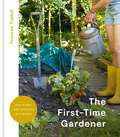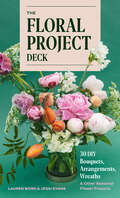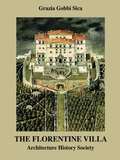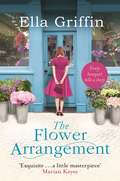- Table View
- List View
The Evolution of the English House (Routledge Revivals)
by Sidney Oldall AddyThe Evolution of the English House (1933) discusses the popular and native art in domestic English architecture, tracing the changes over the years. The focus is on plain wattled huts and combinations of dwelling-house and cattle-stall, as well as the great villas and picturesque timber houses of the wealthy. In this way the author establishes how the masses of the English people lived in past times.
The Evolving Arab City: Tradition, Modernity and Urban Development (Planning, History and Environment Series)
by Yasser ElsheshtawyToday cities of the Arab world are subject to many of the same problems as other world cities, yet too often they are ignored in studies of urbanisation. This collection reveals the contrasts and similarities between older, traditional Arab cities and the newer oil-stimulated cities of the Gulf in their search for development and a place in the world order. The eight cities which form the core of the book – Rabat, Amman, Beirut, Kuwait, Manama, Doha, Abu Dhabi and Riyadh – provide a unique insight into today’s Middle Eastern city. Winner of The International Planning History Society (IPHS) Book Prize.
The Exposed City: Mapping the Urban Invisibles
by Nadia AmorosoThere is a vast amount of information about a city which is invisible to the human eye – crime levels, transportation patterns, cell phone use and air quality to name just a few. If a city was able to be defined by these characteristics, what form would it take? How could it be mapped? Nadia Amoroso tackles these questions by taking statistical urban data and exploring how they could be transformed into innovative new maps. The "unseen" elements of the city are examined in groundbreaking images throughout the book, which are complemented by interviews with Winy Maas and James Corner, comments by Richard Saul Wurman, and sections by the SENSEable City Lab group and Mark Aubin, co-founder of Google Earth.
The Exquisite Book of Paper Flower Transformations: Playing with Size, Shape, and Color to Create Spectacular Paper Arrangements
by Livia Cetti&“Equips crafters with the skills for creating individual flowers and larger arrangements while providing a delightful overview on the basics of botany.&” —Publishers Weekly In The Exquisite Book of Paper Flower Transformations, artist Livia Cetti ups the ante with a host of grander and more intricate flowers and projects—more blooms, more petals, stronger stems, and bigger, bolder arrangements! Cetti will teach you how to play with size, shape, color, and texture to create twenty-five vibrant single stems in a variety of natural shapes—globes, spikes, bells, saucers, rectangles, cones, and arcs—including hydrangeas, coral charm peonies, honeysuckles, and paperwhites. Then, you&’ll use these elemental shapes to build the 15 bright, abundant arrangements, including bold wreaths, bountiful bouquets, fantastical gilded wall art, and blooming garlands. Introducing new, never-before-seen techniques for dyeing paper and creating moldable leaves and petals, this gorgeous guide is perfect for crafters of all skill levels interested in making realistic and unique home decor, gifts, accessories, and entertaining essentials. &“Unlike fresh-cut flowers, paper blooms last forever. And if you make them like floral stylist, crafter and creative director Livia Cetti, they might even be mistaken for the real thing. One of the top paper-flower artists in the U.S.&” —House & Home
The Family Preparedness Buyer's Guide: The Best Survival Gear, Tools, and Weapons for Your Skills and Budget
by Living Ready Magazine EditorsThe essential guide to survival plan essentials! The key to being prepared is to have the things you need ahead of time--before an emergency happens. During these uncertain times, there is no such thing as being over prepared. With the huge range of potential disasters to prepare for, it can be overwhelming trying to decide which items are best to include in your survival plans. The Family Preparedness Buyer's Guide is an all-in-one guide to essential equipment that meets all basic survival needs. Applying this information to your survival plans will ensure your loved ones will be provided with adequate shelter, water, food and then some in a variety of emergency situations. Inside you'll find: Chapters arranged by survival category--survival kits; emergency shelter, fire and clothing; lighting and power sources; hydration and water purification; emergency food and cooking gear; multipurpose tools, first aid and hygiene; survival knives and cutting tools; communication and navigation tools; and survival guns. Lists of specifications for various disaster products so you can compare across brands and models and select the gear that is right for you Detailed feature articles for each gear type so you understand why the gear is essential before purchasing anything Reviews of specific gear and survival-related products When you are prepared, you're not just hoping for the best, you're planning for the best possible outcome no matter what life throws at you. Begin preparing today.
The Farm Girl's Guide to Preserving the Harvest: How to Can, Freeze, Dehydrate, and Ferment Your Garden's Goodness
by Ann Accetta-ScottPreserving food can be one of the most intimidating aspects of homesteading and cooking. Luckily, no one makes it as easy and as much fun as farm-girl-in-the-making Ann Acetta-Scott. For a beginner new to the world of preserving, the ideal tool is a detailed reference guide, and in The Farm Girl&’s Guide to Preserving the Harvest, Ann covers all the basics on canning, dehydrating, freezing, fermenting, curing, and smoking, including how to select and use the right tools for each method.This guide takes home preservers through the beginning, moderate, and advanced stages of preserving. Newcomers can start with a simple jam and jelly recipe using a hot water bath canner, while others may be advanced enough to have mastered the pressure canner and are ready to move onto curing and smoking meat and fish. With more than 30 delicious and healthy recipesand Ann's expertise and encouragement, the home preserver will build confidence in the most common methods of preserving.
The Farmer's Wife Guide To Growing A Great Garden And Eating From It, Too!: Storing, Freezing, and Cooking Your Own Vegetables
by Barbara DoyenA delightfully original package, this book gives advice on growing your favorite vegetables, and then provides ample instructions on how to prepare or preserve the results.
The Farmer's Wife Guide to Fabulous Fruits and Berries: Growing, Storing, Freezing, and Cooking Your Own Fruits and Berries
by Barbara DoyenThis book gives advice on growing your favorite fruits and berries, and then provides ample instruction on how to prepare or preserve the results. The perfect resource for both beginners and experts in America's #1 hobby, gardening.
The Farmhouse of Second Chances: A gorgeously uplifting story of new beginnings!
by Helen Rolfe'A heartwarming story about family, forgiveness and the importance of kindness' FIONA HARPER on The Kindness Club on Mapleberry Lane'Comforting and uplifting, this book is a joy to read' MY WEEKLY'A heartwarming tale' WOMAN'S OWNHome is where the heart is... Joy has made a family for herself. She's turned her beautiful old farmhouse into a safe haven for anyone who is looking for a new beginning. She's always ready with a kind word, a nugget of advice and believes that anyone can change their life for the better, if they really want to. Libby has exchanged her high-flying job in New York for a break in the quiet Somerset countryside. She's soon drawn into Joy's world and into her family of waifs and strays - including Drew, whom Joy once helped get back on his feet. So when a secret from Joy's past threatens everything, can the unlikely group come together to give Joy a second chance of her own? Curl up with this uplifting new story of second chances and finding where you belong, from the author of The Little Village Library, perfect for fans of Cathy Bramley and Ali McNamara!***Readers adore Helen's heartwarming storytelling'Enchanting... Employing all the warmth and charm of Maeve Binchy, and a special brand of kindness that she has made her own, Rolfe weaves together elements of mystery, romance, family relationships and the warmth of community in a story guaranteed to bring laughter, tears and miles of smiles' Lancashire Post'A warm, comforting tale of family and community which brims with kindness and love' Annie Lyons'A heartwarming story about family, forgiveness and the importance of kindness... If you're looking for a feelgood novel in these difficult times, this is definitely it!' Fiona Harper'A lovely community, full of friendship and love''I enjoyed every minute of this book and found it very hard to put down''Lovely, feel-good...filled with lots of love''Gave you all the emotions: suspense, happiness and excitement''Helen Rolfe's writing brought a smile to my face''Loved loved loved this fabulous book'
The Farmhouse of Second Chances: A gorgeously uplifting story of new beginnings!
by Helen Rolfe'A heartwarming story about family, forgiveness and the importance of kindness' FIONA HARPER on The Kindness Club on Mapleberry Lane'Comforting and uplifting, this book is a joy to read' MY WEEKLY'A heartwarming tale' WOMAN'S OWNHome is where the heart is... Joy has made a family for herself. She's turned her beautiful old farmhouse into a safe haven for anyone who is looking for a new beginning. She's always ready with a kind word, a nugget of advice and believes that anyone can change their life for the better, if they really want to. Libby has exchanged her high-flying job in New York for a break in the quiet Somerset countryside. She's soon drawn into Joy's world and into her family of waifs and strays - including Drew, whom Joy once helped get back on his feet. So when a secret from Joy's past threatens everything, can the unlikely group come together to give Joy a second chance of her own? Curl up with this uplifting new story of second chances and finding where you belong, from the author of The Little Village Library, perfect for fans of Cathy Bramley and Ali McNamara!***Readers adore Helen's heartwarming storytelling'Enchanting... Employing all the warmth and charm of Maeve Binchy, and a special brand of kindness that she has made her own, Rolfe weaves together elements of mystery, romance, family relationships and the warmth of community in a story guaranteed to bring laughter, tears and miles of smiles' Lancashire Post'A warm, comforting tale of family and community which brims with kindness and love' Annie Lyons'A heartwarming story about family, forgiveness and the importance of kindness... If you're looking for a feelgood novel in these difficult times, this is definitely it!' Fiona Harper'A lovely community, full of friendship and love''I enjoyed every minute of this book and found it very hard to put down''Lovely, feel-good...filled with lots of love''Gave you all the emotions: suspense, happiness and excitement''Helen Rolfe's writing brought a smile to my face''Loved loved loved this fabulous book'
The Feng Shui Bible: Godsfield Bibles
by Simon G. BrownFrom understanding the basic principles of feng shui to mastering floor plans and using remedies to cure real-life problems, this definitive guide covers everything you need to know about this ancient art. It includes advice on moving house, tailoring feng shui to your personal requirements, choosing furnishings and deciding when to redecorate.The comprehensive directory shows you how you can apply feng shui to every aspect of your life - including your home, health, relationships, finances, career and spiritual life - to help you achieve your full potential, take control of your destiny and create a happier atmosphere at home.
The Feng Shui Bible: Godsfield Bibles (Godsfield Bibles)
by Simon G. BrownFrom understanding the basic principles of feng shui to mastering floor plans and using remedies to cure real-life problems, this definitive guide covers everything you need to know about this ancient art. It includes advice on moving house, tailoring feng shui to your personal requirements, choosing furnishings and deciding when to redecorate.The comprehensive directory shows you how you can apply feng shui to every aspect of your life - including your home, health, relationships, finances, career and spiritual life - to help you achieve your full potential, take control of your destiny and create a happier atmosphere at home.
The Field Guide to Peppers: 400 Varieties - Where They Come From - How Hot They Are
by Dave DeWitt Janie LamsonThe essential guide for pepper enthusiasts! A little spice can really take a meal to the next level—but with so many peppers to choose from, how do you pick one capsicum from another? In The Field Guide to Peppers, Dave DeWitt and Janie Lamson give expert advice on popular varieties like ancho, cayenne, jalapeño, serrano, and more. The 400 profiles in this fiery guide include all the major types of peppers, and each page features a color photograph along with all the details a pepperhead needs to know: common name, origin, source, pod length and width, plant height, color, harvest, and heat level, ranging from sweet to superhot.
The Films of Charles and Ray Eames: A Universal Sense of Expectation (Routledge Research in Architecture)
by Eric SchuldenfreiThe Films of Charles and Ray Eames traces the history of the Eameses’ work, examining their evolution away from the design of mass-produced goods and toward projects created as educational experiences. Closely examining how the Eameses described their work reveals how the films and exhibitions they generated were completely at odds with the earlier objectives exemplified in their furniture designs. Shifting away from promoting the consumer-culture, they turned their attention to the presentation of complex sets of scientific, artistic, and philosophical ideas. During a critical period from the late 1950s to the early 1960s there was a moment of introspective self-reflection in the West stemming from the events of the Cold War. This moment of uncertainty was crucial, for it provided the incentive to question the values and concerns of society as a whole. In turn, designers began to question their own sense of purpose, temporarily expanding the purview of design to a broader field of inquiry. In the case of the Eameses, they identified an overriding problem related to consumerism and excess in America and sought to resolve the issue by creating a network of communication between universities, governments, institutions, and corporations. The solution of promoting greater education experiences as an alternative to consumerism in America required that different sectors of society functioned in unison to address political, social, economic, and educational concerns. The Films of Charles and Ray Eames reconsiders how design intersects with humanity, culture, and the sciences.
The Fine Art of Paper Flowers: A Guide to Making Beautiful and Lifelike Botanicals
by Aya Brackett Tiffanie TurnerAn inspiring, practical and gorgeous guide to crafting the most realistic and artful paper flowers for arrangements, art, décor, wearables and more, from San Francisco botanical artist Tiffanie Turner. The Fine Art of Paper Flowers is an elevated art and craft guide that features complete step-by-step instructions for over 30 of Tiffanie Turner’s widely admired, unique, lifelike paper flowers and their foliage, from bougainvillea to English roses to zinnias. In the book, Turner also guides readers through making her signature giant paper peony, shares all of her secrets for special paper treatments, candy-striping, playing with color and creating botanical imperfections, and shows how to turn paper flowers into gorgeous garlands, headdresses, bouquets and more. These stunning creations can be made from simple and inexpensive materials and the book's detailed tutorials and beautiful photography make it easy to achieve dramatic and lifelike results.
The First Apartment Book: Cool Design for Small Spaces
by Kyle SchunemanBreak out of the white-walled world of first apartments and tap in to your blue-sky decorating dreams with star designer Kyle Schuneman's smart, bold ideas for any budget. First apartments are so exciting because you can finally do what you want with your own space, but they can be tricky to decorate. Kyle Schuneman knows that a paper-thin wallet and four plain walls don't have to stand between you and your perfect home. Kyle, 26, is a decorating prodigy who has designed first apartments for friends, clients, and himself, braving logic-defying floor plans, space-challenged rooms, and picky landlords. In The First Apartment Book, Kyle shares brilliant design ideas and thirty simple DIY projects that show how anyone can infuse a first home with personality whether you're renting, moving in with a roommate or significant other for the first time, or are a newly minted owner eager to put your stamp on your place. The First Apartment Book is both a tour of amazing photographs from ten real homes across the country and a hardworking resource of great ideas. Kyle explains how each of the featured apartments achieves the perfect balance between cool design and the homeowner's lifestyle, with a sprinkling of influences from the resident's city thrown in. Kyle scours flea markets for functional pieces with personality and incorporates Pollock-inspired art and touches of taxicab yellow to make a small studio in New York City function as four different yet coherent rooms. o Graffiti-like dip-dye curtains and a skateboard table reflect a Seattle renter's hip sensibility. In Cleveland, Kyle creates a modern preppy space for a plaid-loving local using subdued colors and careful pattern mixing. A couple's salon-style hanging of rock posters in Nashville feels utterly unique, and Kyle's clever ideas for storing to store their musical instruments keep the duo sane. Short on time and long on style, the thirty DIY projects include no-sew pillows, yarn-wrapped picture frames, and a dresser update using a little glue and fabric. Full of bold, vibrant photos and hundreds of big ideas for small spaces, The First Apartment Book proves that no matter what your landlord, your floor plan, or your wallet says, there are no limits on how cool your first apartment can be.
The First Lie: An addictive psychological thriller with a shocking twist
by A. J. ParkThe most gripping psychological thriller you'll read this year - perfect for fans of Lisa Jewell, Mark Edwards, Claire McGowan, TM Logan and KL Slater...'This is a real page turner. I finished it in one go!' - MARTINA COLE'A.J. Park is a master of suspense who knows how to keep readers hovering tensely over the edges of their seats' - SOPHIE HANNAH******************A freak accident. An impossible choice. But what was...THE FIRST LIE?When Paul Reeve comes home to find his wife in the bathroom, bloodied and shaking, his survival instinct kicks in.Alice never meant to kill the intruder. She was at home, alone, and terrified. She doesn't deserve to be blamed for it. Covering up the murder is their only option.But the crime eats away at the couple and soon they can't trust anyone - even one another...******************Praise for THE FIRST LIE:'A great thriller that will keep you turning the pages well into the night' LUCA VESTE'Twisty, layered and compelling. A genuine page-turner' MW CRAVEN'Tightly plotted, well-drawn characters and an edge of your seat page-turner' CATHY KELLY'Splendildy twisty, it keeps its secrets until the final pages' DAILY MAIL
The First Lie: An addictive psychological thriller with a shocking twist
by A. J. ParkThe most gripping psychological thriller you'll read this year - perfect for fans of Lisa Jewell, Mark Edwards, Claire McGowan, TM Logan and KL Slater...'This is a real page turner. I finished it in one go!' MARTINA COLE'A.J. Park is a master of suspense who knows how to keep readers hovering tensely over the edges of their seats' SOPHIE HANNAH*****THEY HID THE BODY. THEY KEPT THE SECRET. BUT WHAT WAS THE FIRST LIE?When Paul Reeve comes home to find his wife in the bathroom, bloodied and shaking, his survival instinct kicks in.Alice never meant to kill the intruder. She was at home, alone, and terrified. She doesn't deserve to be blamed for it. Covering up the murder is their only option.But the crime eats away at the couple and soon they can't trust anyone - even one another...*****Praise for THE FIRST LIE:'A great thriller that will keep you turning the pages well into the night' LUCA VESTE'Twisty, layered and compelling. A genuine page-turner' MW CRAVEN'Tightly plotted, well-drawn characters and an edge of your seat page-turner' CATHY KELLY'Splendidly twisty, it keeps its secrets until the final pages' DAILY MAIL
The First-Time Gardener
by Frances TophillAlthough excited by the prospect of moving into their own home for the first time, many people are mystified by the prospect of what to do with their outdoor space. Frances Tophill's fuss-free, practical guide shows you how to create a space outside your own back door that's designed by you, built by you and enjoyed by you. Beginning with advice on getting to know your garden - what type of soil you have, what the drainage and light is like - then on getting to know yourself as a gardener - do you want a vegetable patch, an abundance of flowers or simply an extension of your indoor living space? - and then moving on to the practical design, including hard and soft landscaping and building materials and guidance, Frances guides you through different types of plants and how to source and plant them. There is also a section on aftercare, telling you the best way to keep your garden well cared for and easy to maintain throughout the year.
The First-Time Gardener
by Frances Tophill'A brilliant and inspirational starter kit for anyone who wants to make a garden to suit their own needs.' - Alan TitchmarshAlthough excited by the prospect of moving into their own home for the first time, many people are mystified at the thought of what to do with their outdoor space. Frances Tophill's fuss-free, practical guide shows you how to create a space outside your own back door that's designed by you, built by you and enjoyed by you. Beginning with advice on getting to know your garden - what type of soil you have, what the drainage and light is like - then on getting to know yourself as a gardener - do you want a vegetable patch, an abundance of flowers or simply an extension of your indoor living space? - and then moving on to the practical design, including hard and soft landscaping and building materials and guidance, Frances guides you through different types of plants and how to source and plant them. There is also a section on aftercare, telling you the best way to keep your garden well cared for and easy to maintain throughout the year.
The First-Time Gardener
by Frances Tophill'A brilliant and inspirational starter kit for anyone who wants to make a garden to suit their own needs.' - Alan TitchmarshAlthough excited by the prospect of moving into their own home for the first time, many people are mystified at the thought of what to do with their outdoor space. Frances Tophill's fuss-free, practical guide shows you how to create a space outside your own back door that's designed by you, built by you and enjoyed by you. Beginning with advice on getting to know your garden - what type of soil you have, what the drainage and light is like - then on getting to know yourself as a gardener - do you want a vegetable patch, an abundance of flowers or simply an extension of your indoor living space? - and then moving on to the practical design, including hard and soft landscaping and building materials and guidance, Frances guides you through different types of plants and how to source and plant them. There is also a section on aftercare, telling you the best way to keep your garden well cared for and easy to maintain throughout the year.
The First-Time Gardener: How To Plan, Plant And Enjoy Your Garden
by Frances TophillAlthough excited by the prospect of moving into their own home for the first time, many people are mystified by the prospect of what to do with their outdoor space. Frances Tophill's fuss-free, practical guide shows you how to create a space outside your own back door that's designed by you, built by you and enjoyed by you. Beginning with advice on getting to know your garden - what type of soil you have, what the drainage and light is like - then on getting to know yourself as a gardener - do you want a vegetable patch, an abundance of flowers or simply an extension of your indoor living space? - and then moving on to the practical design, including hard and soft landscaping and building materials and guidance, Frances guides you through different types of plants and how to source and plant them. There is also a section on aftercare, telling you the best way to keep your garden well cared for and easy to maintain throughout the year.
The Floral Project Deck: 30 DIY Bouquets, Arrangements, Wreaths & Other Seasonal Flower Projects
by Lauren Work Jessi EvansPacked with easy-to-follow instructions, gorgeous photographs, and recipes for 30 breathtaking floral arrangements, this handy DIY deck gives you the power to create floral displays that will elevate any occasion.Design stunning floral arrangements for holiday hosting, special occasions, gifting to friends, or simply making any day a little brighter and more beautiful. This easy-to-use deck includes 30 how-to recipe cards for creating gorgeous seasonal arrangements, including: A lush harvest tablescape A welcoming holiday wreath A summer-sweet centerpiece for al fresco dining A “grateful guest” bundle to present to your host Bouquets for Valentine's Day, Mother’s Day, and more A petite booklet outlines the basics—essential tools and a flower glossary for easy reference—to get you started, and each card features a photo of a flower arrangement and step-by-step instructions. The Floral Project Deck makes it easier than ever for flower lovers to make their own gorgeous designs at home.FLOWER ARRANGING FOR ALL: These flower recipes are uncomplicated, and every card provides clear instructions and a photo, ensuring any hobbyist can easily recreate these beautiful bouquets and bundles regardless of skill level. FLORAL ART THROUGHOUT THE YEAR: A simmer pot to welcome the new year, a pastel bouquet for Mother's Day, a charming flower crown to mark the summer solstice, a colorful kale autumnal centerpiece, a festive holiday wreath: These 30 floral projects incorporate seasonal blooms, ensuring you have a gorgeous arrangement for every time of year. GIFT FOR FLOWER LOVERS: With beautiful flower photography and an eye-catching package, The Floral Project Deck makes a lovely companion for flower enthusiasts and a perfect present for any celebratory occasion.Perfect for: Anyone who likes to arrange flowers Novice or professional florists Gardeners, flower lovers, and nature enthusiasts People who buy blooms at the farmer’s market or grocery store Gift-giving for Mother's Day, birthday, housewarming, or holiday
The Florentine Villa: Architecture History Society (The Classical Tradition in Architecture)
by Grazia Gobbi SicaScholarly and innovative with visually stunning line drawings and photographs, this volume provides readers with a compelling record of the unbroken pattern of reciprocal use and exchange between the countryside and the walled city of Florence, from the thirteenth century up to the present day. Defying the traditional and idealized interpretation of the Florentine Villa, the author: analyzes the economic factors that powered the investment in and building of country houses and estates from the early Renaissance times onwards, as well as the ideology and the architectural and literary models that promoted the Florentine villa explores the area between Florence and Sesto in its history, morphology and representation looks at the villas existing in the area. A contribution to the protection of the important cultural heritage of the landscape in the Florentine area and of its historic buildings, villas and gardens, this study makes engaging reading, not only for scholars and students in architecture, landscape design and social history, but also for the well informed reader interested in art, architecture and gardens.
The Flower Arrangement: An uplifting, moving page-turner.
by Ella GriffinDrawing together heartwarming characters and a story that will keep you turning the pages, The Flower Arrangement is a captivating tale woven around a Dublin florist.Every bouquet tells a story...And every story begins at Blossom & Grow, a tiny jewel-like flower shop in the heart of Dublin. Here, among the buckets of fragrant blooms, beneath the flickering candles and lanterns, florist Lara works her magic, translating feelings into flower arrangements, changing hearts and lives. Whether its bridal posies, anniversary bouquets or surprise deliveries from secret admirers, Lara arranges the flowers for all manner of life-changing moments. No stranger to heartbreak herself, Lara knows flowers say more than words ever can. But can the flowers that heal the customers work their magic on Lara? The perfect feel-good escapist read for fans of Erica James, Roisin Meaney and Lucy Dillon.
